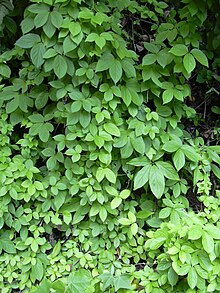Dioscorea pentaphylla
| fiveleaf yam | |
|---|---|

| |
| Scientific classification | |
| Kingdom: | Plantae |
| Clade: | Tracheophytes |
| Clade: | Angiosperms |
| Clade: | Monocots |
| Order: | Dioscoreales |
| Family: | Dioscoreaceae |
| Genus: | Dioscorea |
| Species: | D. pentaphylla
|
| Binomial name | |
| Dioscorea pentaphylla | |
| Synonyms[1] | |
| |
| Nutritional value per 100 g (3.5 oz) | |
|---|---|
| Energy | 343 kJ (82 kcal) |
20 g | |
0.08 g | |
1.73 g | |
| Vitamins | Quantity %DV† |
| Thiamine (B1) | 7% 0.086 mg |
| Riboflavin (B2) | 1% 0.014 mg |
| Niacin (B3) | 1% 0.13 mg |
| Pantothenic acid (B5) | 10% 0.48 mg |
| Vitamin B6 | 12% 0.209 mg |
| Folate (B9) | 3% 12 μg |
| Minerals | Quantity %DV† |
| Iron | 2% 0.43 mg |
| Magnesium | 2% 10 mg |
| Manganese | 12% 0.283 mg |
| Phosphorus | 3% 40 mg |
| Potassium | 17% 495 mg |
| Sodium | 1% 12 mg |
| Zinc | 3% 0.32 mg |
| †Percentages estimated using US recommendations for adults,[2] except for potassium, which is estimated based on expert recommendation from the National Academies.[3] | |
Dioscorea pentaphylla is a species of flowering plant in the yam family known by the common name fiveleaf yam. It is native to southern and eastern Asia (China, India, Indochina, Indonesia, Philippines, etc.) as well as New Guinea, Sri Lanka and northern Australia. It is widely cultivated as a food crop and naturalized in Cuba and on several island chains in the Pacific (including Hawaii).[1][4][5][6][7][8][9][10][11][12]
Dioscorea pentaphylla is a prickly vine that twines counterclockwise around objects and other plants. It may reach 10 meters in length. The alternately arranged leaves are compound, divided into 3 to 5 leaflets each up to 10 centimeters long. The plant produces horseshoe-shaped bulbils about a centimeter long. New plants can sprout from the bulbils. Flowers are borne in spikes. The vine grows from a tuber. Specimens may weigh 3 pounds and may be located over a meter underground.[4]
The tubers of the vine can be cooked and eaten.[13]
References
- ^ a b Kew World Checklist of Selected Plant Families
- ^ United States Food and Drug Administration (2024). "Daily Value on the Nutrition and Supplement Facts Labels". Retrieved 2024-03-28.
- ^ National Academies of Sciences, Engineering, and Medicine; Health and Medicine Division; Food and Nutrition Board; Committee to Review the Dietary Reference Intakes for Sodium and Potassium (2019). Oria, Maria; Harrison, Meghan; Stallings, Virginia A. (eds.). Dietary Reference Intakes for Sodium and Potassium. The National Academies Collection: Reports funded by National Institutes of Health. Washington (DC): National Academies Press (US). ISBN 978-0-309-48834-1. PMID 30844154.
{{cite book}}: CS1 maint: multiple names: authors list (link) - ^ a b Gucker, Corey L. 2009. Dioscorea spp. In: Fire Effects Information System, [Online]. U.S. Department of Agriculture, Forest Service, Rocky Mountain Research Station, Fire Sciences Laboratory.
- ^ Flora of China, Vol. 24 Page 289, 五叶薯蓣 wu ye shu yu, Dioscorea pentaphylla Linnaeus, Sp. Pl. 2: 1032. 1753.
- ^ Smith, A.C. (1979). Flora Vitiensis Nova. A new flora for Fiji (Spermatophytes only) 1: 1-495. Pacific Tropical Botanical Garden, Lawai.
- ^ Morat, P. & Veillon, J.-M. (1985). Contributions à la conaissance de la végétation et de la flore de Wallis et Futuna. Bulletin du Muséum National d'Histoire Naturelle. Section B, Adansonia 7: 259-329.
- ^ Tanaka, N., Koyama, T. & Murata, J. (2005). The flowering plants of Mt. Popa, central Myanmar - Results of Myanmar-Japanese joint expeditions, 2000-2004. Makinoa 5: 1-102.
- ^ Samanta, A.K. (2006). The genus Dioscorea L. in Darjeeling and Sikkim Himalayas - a census. Journal of Economic and Taxonomic Botany 30: 555-563.
- ^ Govaerts, R., Wilkin, P. & Saunders, R.M.K. (2007). World Checklist of Dioscoreales. Yams and their allies: 1-65. The Board of Trustees of the Royal Botanic Gardens, Kew.
- ^ Wilkin, P. & Thapyai, C. (2009). Flora of Thailand 10(1): 1-140. The Forest Herbarium, National Park, Wildlife and Plant Conservation Department, Bangkok.
- ^ Acevedo-Rodríguez, P. & Strong, M.T. (2012). Catalogue of seed plants of the West Indies. Smithsonian Contributions to Botany 98: 1-1192.
- ^ Dioscorea pentaphylla. Archived 2016-03-04 at the Wayback Machine University of Michigan Ethnobotany.
